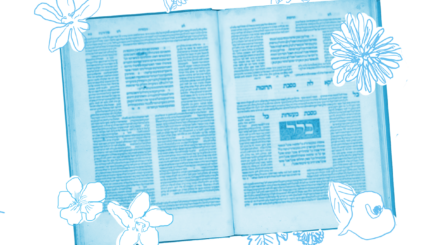A mishnah at the end of yesterday’s daf listed a number of circumstances in which the intent to perform part of a sacrificial ritual outside of its regular time disqualifies the sacrifice and makes those who eat it liable for karet. So if a person merely intends to sprinkle the blood of a sacrifice or to eat its meat at the wrong time, the sacrifice doesn’t count. The list includes:
One who intends to partake of an olive bulk of skin of the tail the next day.
The Gemara is surprised to find this item on the list, noting:
The students assumed that the skin of the tail is considered as though it were part of the tail itself.
Generally speaking, the skin of an animal is not considered meat, so it would neither be consumed on the altar nor eaten by the person bringing the sacrifice. But the skin on the underside of a sheep tail is different. It is soft and fatty and at times is considered meat (see Mishnah Hullin 9:2).
Our mishnah is talking about peace offerings, parts of which are consumed on the altar and parts of which are eaten. The tail is in the former category — it is burnt on the altar and not eaten. If, as the students assume, the skin of the tail is considered part of the tail, then it should be consumed on the altar as well. But the mishnah includes it on the list of things a person is punished for eating outside of the prescribed time frame. How can that be if the tail is not eaten?
The discussion that follows seeks to resolve this problem in a number of ways. Rav Huna, based upon a close reading of Leviticus 3:9, suggests that the assumption of the students may be wrong. The verse, which describes the peace offering, reads: “And he [the priest] shall offer of the sacrifice of the peace offering, an offering made by fire to the Lord; the fat thereof, the fat tail.” Rav Huna notes that “the fat thereof ” appears to be superfluous. If we are to offer up “the fat tail,” doesn’t that already include “the fat thereof?” Rather, the phrase must be emphasizing that it is the fat which is included in the offering, not the skin. In other words, the skin is not treated like the tail — it is not burnt on the altar and is left to be eaten.
Rav Hisda suggests another possibility. He agrees with the students that the skin of the sheep tail is considered like the tail. However, he argues that this has no bearing on our case. How so? The mishnah, he says, is not talking about a sheep offering, but about a goat offering. And the tail of a goat is not consumed on the altar, so the one who brought the sacrifice could intend to eat it after the deadline for doing so has passed.
Shmuel offers a third possibility. He agrees with the students that the skin of the sheep tail is like the tail and he believes that the mishnah is talking about a sheep offering. Rather, citing Rabbi Eliezer, he says the issue is intent.
One who has the intent (to shift an item’s consumption) from consumption by the altar to consumption by a person, or from consumption by a person to consumption by the altar, renders the sacrifice forbidden.
Rabbi Eliezer expands the mishnah’s prohibition on improper intent to include improper intention regarding how the meat will be consumed (by fire on the altar or by human consumption). Doing so gives the skin of the tail a proper place in our mishnah. It is meant to be burnt on the altar, but intending to eat it disqualifies the sacrifice as a whole.
So to sum up, in response to the students’ objection to including the skin of the tail in the mishnah, we get three possible resolutions: (1) adjust our assumption that the skin of the tail is treated like the tail when it comes to sacrifices (Rav Huna), (2) change our assumption about what kind of animal we are talking about (Rav Hisda), or (3) expand the types of improper intentions that disqualify a sacrifice (Shmuel).
The talmudic back and forth on today’s daf is quite complex and does not leave us with one clear resolution. What is important here is not the resolution, but how the discussion highlights a key characteristic of talmudic discourse: the rabbis’ willingness to adjust their understanding of a text in order to resolve an apparent contradiction.
Read all of Zevachim 28 on Sefaria.
This piece originally appeared in a My Jewish Learning Daf Yomi email newsletter sent on October 12, 2025. If you are interested in receiving the newsletter, sign up here.
With your help, My Jewish Learning can provide endless opportunities for learning, connection and discovery.



